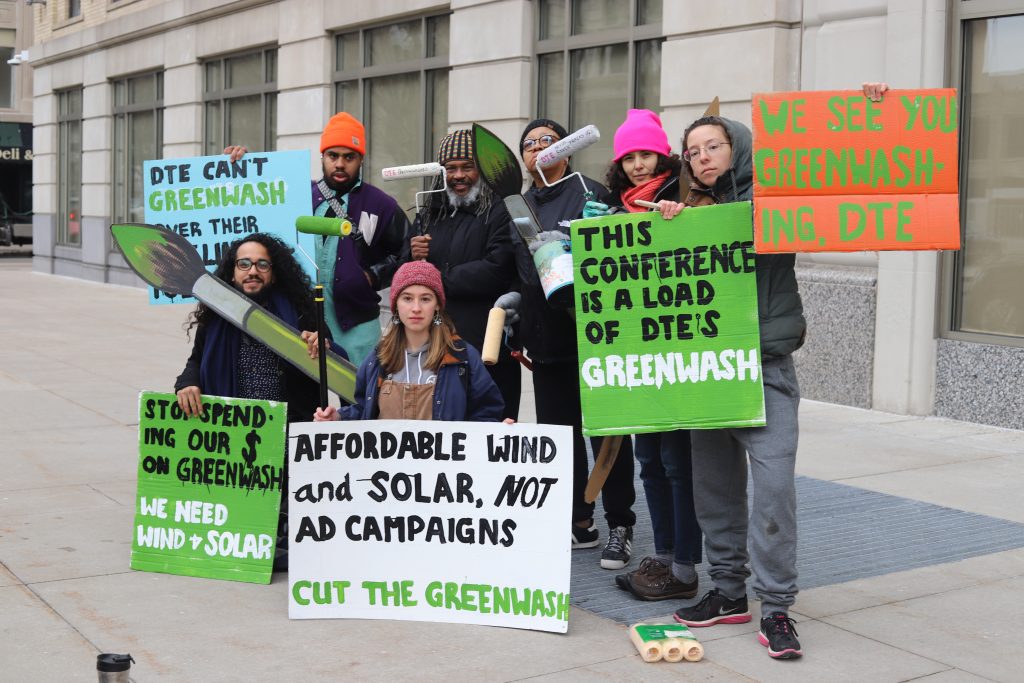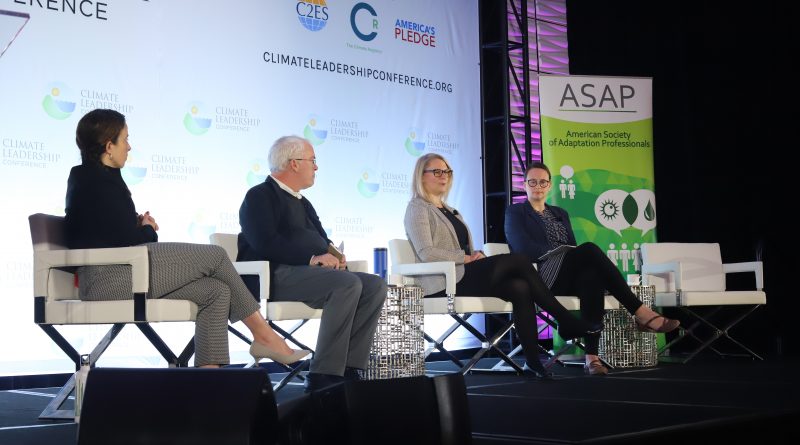Climate Leadership Conference, Day 1: Lessons Learned and Issues Highlighted

Yesterday kicked off the Climate Leadership Conference here in Detroit, which I’m covering from a few angles. The conference is put on by C2ES and America’s Pledge and was sponsored locally by DTE Energy, WSP, IBM, The Nature Conservancy, Dominion Energy, and more.
On my way into the venue, I noticed a small crowd of demonstrators being escorted out by a pair of cordial security guards. Signs castigated DTE for “greenwashing” the event, saying that we need renewable energy, not ad campaigns. I recognized a few familiar faces, including Southwest Detroit native, artist, and community advocate Antonio Cosmé, perhaps most famous (or notorious, perhaps) for having co-created the “Free The Water” graffiti on an old water tower visible off I-75.
Bridget Vial, of the Michigan Environmental Justice Coalition‘s “Work With Me, DTE!” campaign, said in a prepared statement (last link is theirs):
“DTE Energy was recently criticized by the Public Service Commission for undercutting the value of solar and wind energy in its proposed Integrated Resource Plan, a 15-year plan for energy production. The utility has instead placed its bets on a new generation of power plants fueled in part by the NEXUS pipeline, which carries fracked gas from Ohio and in which DTE has made legally dubious investments.”
THE CONFERENCE: SUSTAINABILITY FOR WHOMST?
Residents of Southwest Detroit may not have the luxury of being able to pay the CLC’s staggering $1,595 registration fee. But indeed, the neighborhood (where I also live) has some of the worst air pollution in the country, thanks in no small part to a trifecta of steel mills, a massive oil refinery, and a customs plaza for the Ambassador Bridge, whence diesel fumes waft at every hour from trucks bringing car parts and widgets to and fro.
This is the schism between what I might call ivory tower environmentalism and what could best be described as grassroots environmentalism or, most generally, community advocacy. The former, perhaps also associated with what I might call, in tongue-in-cheek terms, the “corporate social responsibility industrial complex,” is focused on design, theory, and capital. And certainly, there are parts of it that have enormous value. The latter, on the other hand, is focused on the human level of equity and justice.
It can get very jargony. Ivory Towerism is principally defined by the landscape of what they’re now calling ESG and social impact since the term corporate social responsibility seems to have fallen out of favor. These terms, too, will eventually be replaced as paradigms shift and people get tired of, well, our society making no progress as a whole. (In a nutshell, we do make incremental improvements across generation, but we still live in a world with widespread and completely unnecessary suffering and poverty, so, it becomes necessary to periodically retool language and strategies).
I’ll break these down briefly.
Environmental, Social, and Governance (ESG)
ESG. The idea here is that we can create standardized metrics to compare companies, investments, and more. The upside is that there are many universal metrics and systems to understand energy, carbon footprint, and other sustainability metrics and compare companies across these. Diversity by ethnic group, for example, is a relatively straightforward metric. The downside? Some practical downsides involve the challenge of sorting through marketing collateral to understand real value. A steel mill can hypothetically be “greener” than a corporate campus with LEED Platinum buildings. Another downside is that there’s a large “and then what?” component to ESG. There are plenty of companies that tout ESG records while still engaging in pretty ruthless environmental and social practices.
SOCIAL IMPACT
Social impact investment is often focused on investing either as donations or grants (no direct return expected) or on investing at a very low return. Some of it is clever marketing, like when Wells Fargo or Chase Bank talked up the virtues of their massive investments in Detroit—which were actually just part of a monumental DOJ settlement. It’s astounding that it’s even legal to market these programs as charitable and socially oriented in cases when they are actually judicially mandated– as punishment for doing something that is exactly the opposite.
“There is also a profound disconnect between spending five days talking about mindfulness, reflection, social justice, and equity, and then going back to your 9-5 job making six figures for Daddy Bezos.”
I thought about this a lot at the StartingBloc Institute, too (I’m a Social Innovation Fellow now, by the way! Check out the LinkedIn!). I was butting heads with people who were insisting on using reusable Tupperware while also insisting on driving to the Institute every day. “It’s just easier,” they’d say. That’s fine. But 1) please recognize your privilege in being able to afford a car while we’re having conversations about privilege and equity, and 2) please don’t talk about sustainability and equity while complaining about parking rates while driving when you could take the bus. There is also a profound disconnect between spending five days talking about mindfulness, reflection, social justice, and equity, and then going back to your 9-5 job making six figures for Daddy Bezos.
I do not, by any means, demand ideological purity, something I’ve been thinking about ever since I finished Tressie McMillan Cottom’s book Thick. Cottom pleads for better discourse, suggesting that we can’t be perfect, pointing out instead that we can disagree, but that we can’t give up on each other and we can’t stop asking good questions and challenging ourselves– and others- to improve.
I’m fine with imperfection. I’m fine with conflict.
I’m less excited by disingenuity.
At the registration table, I pick up my media credential from a sea of badges. I noticed the nametag for DTE ex-CEO Gerry Anderson, who for many moons presided over a predictable cycle of the company demanding large rate hikes to improve its infrastructure while it posted billion dollar profits, chose to invest in fossil fuels rather than renewables, and– here’s the kicker- paid no taxes.
“Oh, Gerry,” I murmur out loud. “Wonder if he’s taking the bus in today?”
PART TWO: ADAPTATION, RISK, RESILIENCE
Beth Gibbons of the American Society of Adaptation Professionals, with whom I co-hosted a happy hour last night at Grand Trunk Pub, moderated a morning panel on risk assessment, strategy, and solutions. Matt Naud, Associate Senior Consultant at RRS (Resource Recycling Systems) in Ann Arbor, talked about the uncanny similarities between climate adaptation and disaster relief, invoking familiar imagery we’ve seen in two separate wars– of oil well fires in Iraq and Kuwait, which he worked on.

WSP’s Emily Wasley mentioned the importance of integrative solutions that involve cross-functional collaboration, given that climate change mitigation and adaptation both involve a complex web of moving parts that should all be considered for cost-effective implementation informed by sensible policy.
Missy Stults, Sustainability and Innovations Manager for the City of Ann Arbor, did not mince words in her portrayal of the role of cities in addressing the climate crisis, pointing out that there are tremendous opportunities and challenges associated with climate change patterns that, while probably ultimately benefitting the Great Lakes, will force large numbers of people to move from areas threatened by sea level rise and extreme weather.
“When you’re talking about what you don’t do, you don’t include the cost of the [negative] effects from not mitigating,” she said, referring to the question of financing improvements to vulnerable infrastructure like utilities. “Our utility [DTE] is too focused on big, centralized systems. Nowhere were microgrids even thought about in terms of reducing strain on [the] grid. We intervened in the [Integrated Resource Plan]… we will not tolerate the status quo.”
Stults went on to point out the importance of Ann Arbor recognizing its relative wealth as a city in order to effect systemic improvements that can benefit every resident. “Ann Arbor is an affluent community. It would be fairly easy for us to do this [decarbonization] on our own,” she said, emphasizing the importance of scalable solutions that can transfer value from wealthier consumers to lower-income consumers. She ended on a hopeful note that “maybe [we can] change policy for the entire state.”
(This article is part of a series on the Climate Leadership Conference, taking place this week at the Westin Book Cadillac in downtown Detroit. Additional content will be linked here as it is produced).




